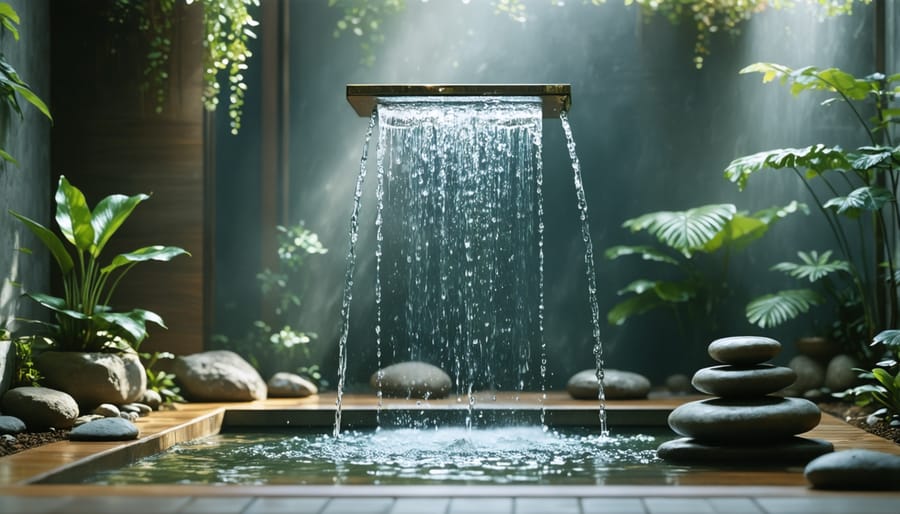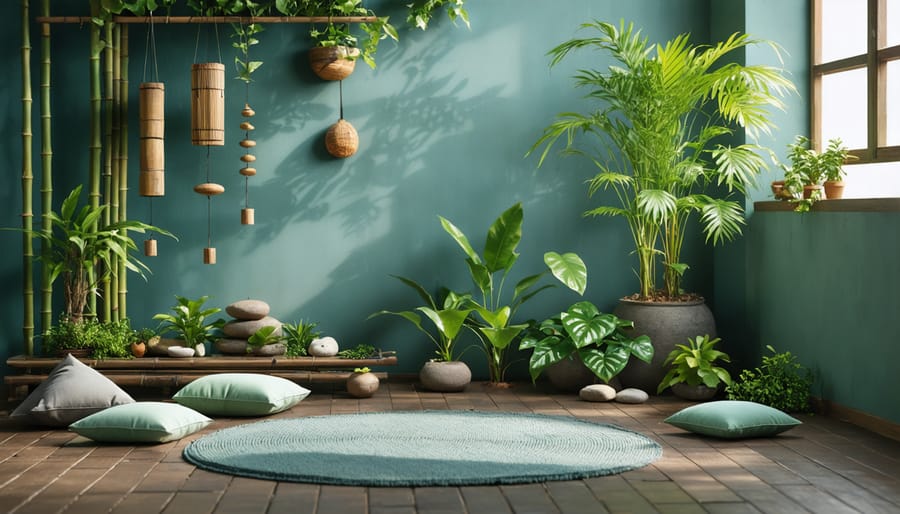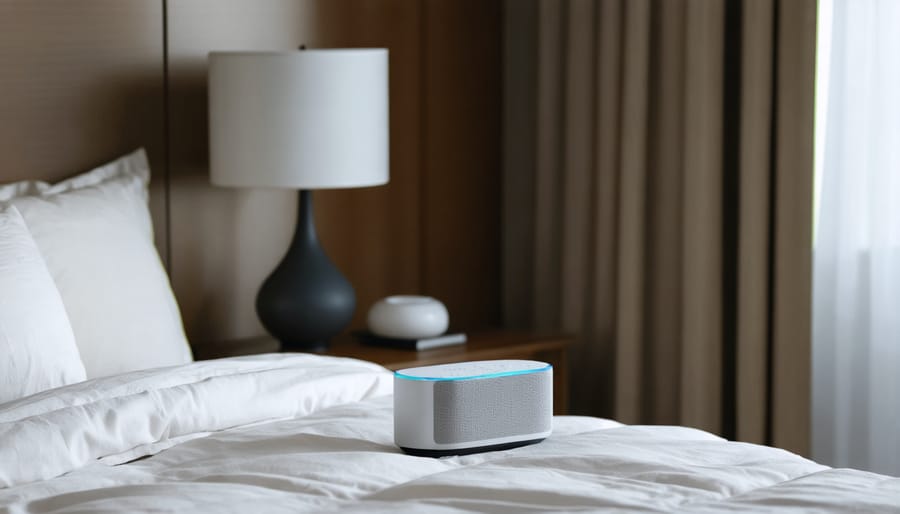Transform your living space into a sanctuary of peace with gentle ocean waves, rustling leaves, and soft rainfall – natural calming soundscapes proven to reduce anxiety levels by up to 65%. Place small water features near workspaces to create continuous, soothing white noise that masks disruptive sounds while promoting focus and relaxation. Position nature sound machines in bedrooms, timing them to gradually decrease volume over 30 minutes for improved sleep quality and reduced nighttime anxiety. Layer different peaceful sounds throughout your home – combine the low hum of a fan with gentle wind chimes near windows, or pair rainfall tracks with soft instrumental music at 432 Hz, the frequency associated with reduced stress responses. Create these therapeutic soundscapes using readily available apps, portable speakers, or dedicated sound machines to transform any room into a tranquil haven where anxiety melts away naturally.
Natural Elements That Soothe
Water Features for Tranquility
The gentle trickle of water has an almost magical ability to melt away stress and create a sense of calm in any space. Water features come in various forms, each offering its own unique contribution to a peaceful atmosphere. Indoor fountains, ranging from compact tabletop models to grand floor installations, produce a consistent, gentle sound that can help mask disturbing noises while promoting relaxation.
Wall-mounted water features are particularly effective, as the water cascading over textured surfaces creates a rich, multi-tonal sound that’s both soothing and natural. For those with limited space, small desktop water fountains can provide similar benefits while fitting perfectly on a nightstand or office desk.
Consider adding river rocks or glass beads to your water feature to create different sound variations. Smooth stones tend to produce softer, more melodic sounds, while rougher surfaces create a more pronounced water effect. The sound of water dropping into water versus running over surfaces offers distinct acoustic experiences, so experiment to find what works best for you.
Maintenance is surprisingly simple – just ensure regular water changes and occasional cleaning to prevent mineral buildup. Many modern water features come with adjustable flow controls, allowing you to customize the sound level to your preference. For maximum tranquility, place your water feature away from electronics and in a quiet corner where the peaceful sounds can naturally fill the space.

Bringing Nature Indoors
Bringing the soothing sounds of nature indoors is one of the most effective ways to create a calming atmosphere in your home. By incorporating biophilic design elements, you can establish a peaceful environment that helps reduce anxiety and promotes relaxation.
Start by adding indoor plants that create gentle rustling sounds when touched by air movement. Peace lilies, bamboo palms, and snake plants not only purify the air but also provide subtle natural acoustics. Position them near windows or air vents to maximize their sound-making potential.
Wind chimes are another excellent addition to your indoor soundscape. Choose ones made from natural materials like bamboo or wood for a softer, more organic tone. Place them near windows or in areas with gentle air circulation to create intermittent, peaceful melodies.
Consider installing a small indoor water feature, such as a tabletop fountain or wall-mounted waterfall. The gentle trickle of water can mask unwanted noise while providing a consistent, calming background sound. For a low-maintenance option, try a white noise machine with nature sound settings that simulate rainfall, forest sounds, or ocean waves.
Don’t forget about natural textures that can influence acoustics. Woven grass cloth wallpaper, cork boards, or bamboo screens can help diffuse sound while adding visual interest to your space. These elements work together to create a multi-sensory experience that connects you with nature’s peaceful rhythms.
Creating Your Sound Zones
Meditation Corner Setup
Creating a dedicated meditation corner in your home is essential for effective meditation sound practices and anxiety relief. Start by choosing a quiet corner of your home, ideally away from high-traffic areas and external noise. This space should be large enough to accommodate comfortable seating and any sound equipment you plan to use.
Consider these elements when setting up your meditation corner:
Seating: Choose a comfortable cushion, meditation pillow, or chair that supports good posture. Ensure it’s positioned against a wall or in a corner to create a sense of security and grounding.
Sound Equipment: Invest in quality speakers or a sound machine that can deliver clear, soothing sounds. Position them at ear level for optimal sound distribution. If using a smartphone or tablet, consider a dedicated stand to keep it at the right height.
Lighting: Install dimmer switches or use soft lighting options like salt lamps or LED candles. Natural light is excellent, but ensure you can control it with curtains or blinds.
Storage: Add a small shelf or cabinet to store your sound equipment, meditation cushions, and other wellness items. This helps keep your space organized and clutter-free.
Acoustic Treatment: Consider adding soft furnishings like curtains, rugs, or tapestries to improve room acoustics and absorb unwanted echo. Plants can also help create a more natural, peaceful atmosphere while improving sound quality.
Remember to keep the space minimal and free from distractions. Your meditation corner should feel like a sanctuary where you can fully immerse yourself in calming sounds and relaxation practices.

Bedroom Sound Solutions
Your bedroom should be a sanctuary of peace, and incorporating the right sounds can transform it into the perfect sleep haven. Start by selecting a high-quality white noise machine, which can effectively mask disruptive external noises while creating a consistent, soothing backdrop for sleep. Position it about 3-6 feet from your bed for optimal sound distribution.
Nature sounds are particularly effective for bedroom relaxation. Consider installing a small tabletop water fountain, which provides gentle water sounds and adds humidity to the room. Rain sounds, ocean waves, or forest ambiance through a dedicated sound machine or smartphone app can also help ease anxiety before bedtime.
For those who prefer musical elements, instrumental compositions at 60-80 beats per minute work best for sleep. Classical music, particularly pieces by Mozart or Beethoven, has been shown to reduce stress and improve sleep quality. Create a peaceful bedroom playlist that runs for about 45 minutes – just long enough to help you drift off.
Smart speakers can be programmed to play calming sounds on a timer, gradually decreasing in volume as you fall asleep. Place them strategically in your room, avoiding positions directly next to your head. If you share your bedroom, wireless sleep headphones are an excellent alternative that won’t disturb your partner.
Remember to keep the volume at a moderate level – around 60-70 decibels, or about the volume of normal conversation. This ensures the sounds are effective without becoming another source of distraction. Test different combinations of sounds and adjust them according to your preferences and sleep patterns.
Technology and Sound Integration
Smart Sound Systems
Modern technology has made it easier than ever to incorporate calming sounds into your daily routine. Smart speakers like Amazon Echo, Google Home, or Apple HomePod can become powerful allies in managing anxiety through sound therapy. These devices offer instant access to a variety of peaceful sounds, from rainfall to ocean waves, with just a voice command.
Setting up your smart sound system is surprisingly simple. Start by placing speakers strategically throughout your home – perhaps one in your bedroom for peaceful sleep, another in your home office for focused work, and one in your living room for general relaxation. Most smart speakers allow you to group multiple devices, creating a synchronized, immersive sound experience throughout your space.
Take advantage of automation features to establish calming routines. Program your speakers to play gentle nature sounds when you wake up, white noise during work hours, or meditation music before bed. Many smart home systems also integrate with other devices, allowing you to pair soothing sounds with dimmed lights or adjusted thermostats for a fully relaxing environment.
For the best results, experiment with different sound combinations and scheduling. You might discover that bird songs work better for your morning routine, while evening rainfall helps you unwind. The beauty of smart systems lies in their flexibility – you can easily adjust and personalize your sound therapy experience as needed.

Sound Masking Solutions
In today’s bustling world, creating a peaceful sound environment often means actively managing unwanted noise. Sound masking technology offers an elegant solution by introducing gentle, consistent background sounds that help mask disruptive noises without being intrusive themselves.
White noise machines are perhaps the most popular sound masking devices, producing a consistent sound that resembles rushing air or rainfall. These compact devices are perfect for bedrooms, home offices, or meditation spaces. For a more natural approach, pink noise generators create sounds that mimic ocean waves or wind rustling through trees, which many find more soothing than traditional white noise.
Smart home integration has revolutionized sound masking solutions. Modern systems can automatically adjust their output based on ambient noise levels, ensuring optimal coverage throughout the day. Some even feature programmable zones, allowing you to create different sound environments in various areas of your home.
For a budget-friendly approach, consider portable sound machines or smartphone apps that offer customizable soundscapes. These solutions are particularly effective in smaller spaces or when traveling. To maximize effectiveness, position your sound masking device between you and the noise source, and experiment with different sound types and volume levels until you find your perfect balance.
Remember that sound masking works best as part of a comprehensive approach to creating a peaceful environment, complementing other elements like proper room layout and sound-absorbing materials.
DIY Sound Projects
Creating your own peaceful sound elements doesn’t have to be complicated or expensive. With a few simple DIY acoustic solutions, you can craft calming soundscapes right at home. Here are three easy projects to get you started:
1. Tabletop Water Feature
Transform an ordinary ceramic bowl into a soothing fountain using a small submersible pump, some decorative stones, and water. Layer the stones around the pump, add water, and enjoy the gentle trickling sound. Pro tip: Add a few drops of essential oils to the water for an aromatherapy boost.
2. Wind Chimes from Upcycled Materials
Create melodic sounds using items you might already have at home. Old keys, copper pipes, or even seashells can be transformed into beautiful wind chimes. Simply drill small holes, string your chosen materials at varying lengths using fishing line or thin rope, and hang from a wooden base. Different materials create unique tones – experiment to find your perfect peaceful melody.
3. Rain Stick Meditation Tool
Using a cardboard tube (like from paper towels), create a gentle rain sound maker. Seal one end with thick paper and tape, then insert a spiral of aluminum foil along the length of the tube. Add small dried beans or rice, seal the other end, and decorate the exterior. When turned over slowly, it produces a peaceful rainfall sound perfect for meditation.
Remember to position your sound elements strategically throughout your space. The key is to create gentle, background sounds that don’t overwhelm the room. Start with one project and add more as you discover what works best for your anxiety-relief needs. These DIY solutions not only provide calming sounds but also add unique decorative elements to your home.
Creating a peaceful soundscape in your home is more than just a decorative choice – it’s an investment in your mental well-being and overall quality of life. As we’ve explored throughout this guide, incorporating calming sounds into your living space can significantly reduce anxiety and create a more harmonious environment.
Remember that you don’t need to transform your entire home at once. Start small by introducing one or two peaceful sound elements, such as a desktop water fountain in your home office or nature sounds in your bedroom. Pay attention to how different sounds affect your mood and anxiety levels, and adjust accordingly.
The key is to personalize your approach. What works for someone else might not work for you, and that’s perfectly fine. Experiment with different combinations of natural sounds, white noise, and gentle music until you find your perfect acoustic balance.
Don’t forget to consider the practical aspects we’ve discussed, like speaker placement and volume levels. Creating a peaceful soundscape is about subtlety and balance – the goal is to enhance your space, not overwhelm it.
Take the first step today in transforming your home into a sanctuary of calm. Whether it’s downloading a nature sounds app, investing in a small water feature, or simply opening your windows to let in natural sounds, you’re on your way to creating a more peaceful, anxiety-reducing environment.
